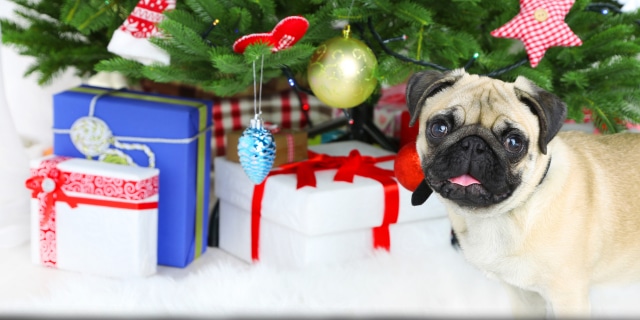
by California Casualty | Pets |
It’s time to spoil the real VIPs in our lives—our pets and the people who love them! Whether you’re shopping for a cat cuddler, a dog devotee, or the proud parent of a feathered friend, finding the perfect gift can make tails wag, whiskers twitch, and hearts melt. From paw-some gadgets to cozy pet accessories, we’ve got a gift guide that’s sure to delight both two-legged and four-legged family members.
For Pets
Bow Wow Labs Buddy Safety Bully Stick Holder
Our dogs love bully sticks but when they get too short, they can become a choking hazard. This bully stick holder helps keep pups safe while chewing and ensures they enjoy their treats to the fullest without worry.
Drinking Fountain
Cats love to drink from running water, and this fountain provides a fresh, flowing drink that encourages hydration. There are many varieties available at a range of price points.
Hide and Slide Treat Dispensing Toy
Dogs must slide blocks and move flippers in order to access the hidden treats in this puzzle toy. Not only does it provide mental stimulation, but it’s also a great way to redirect your pup’s energy away from less desirable behaviors.
Interactive Laser
Keep your kitty entertained with this automatic laser toy that creates random patterns and movements. With 15 minutes of hands-free play and an automatic shutoff feature, it’s an ideal gift for busy cat parents who want to keep their feline friends active and happy.
Matching Hoodies
Choose a matching hoodie—or PJs or sweaters—for you and your pup to twin in style. This particular gift donates a portion of the sales to rescues so you’re giving while getting!
Matching Collar and Owner Friendship Bracelet
Celebrate the bond with your pet by sporting matching accessories! These stylish sets are available for dogs and cats, allowing you to show off your special friendship in a fun and fashionable way.
Pet Cactus Lick Mat
This cleverly designed lick mat helps soothe cats and dogs during stressful moments like grooming, baths, or nail trims. Its maze-like surface not only entertains pets but also gently removes food particles from their tongues, promoting healthier teeth and gums.
Talking Pet Starter Set
If only your dog or cat could talk…well, with this recordable button set, they just might start. Developed by a speech therapist, this could be a fun activity for you and your best friend.
For Pet Parents
Dog Bingo
Dog lovers will enjoy seeing their favorite breeds on this bingo board. It’s a guaranteed hit at your next game night. Don’t worry, cat lovers, there’s a cat version, too.
Doormat
Proclaim your love for pets with a fun doormat or a personalized one. Choose a washable version to make cleaning up those muddy pawprints a breeze.
Furbo Dog Camera
Watch your pet when you’re not at home with this 360-degree camera. The Furbo camera offers two-way audio and treat-dispensing capabilities, making it a must-have for pet parents who want to stay connected while away from home.
Grounds and Hounds Coffee Club
Coffee lovers and dog enthusiasts alike will appreciate this coffee club. Every purchase helps support rescue organizations, so you can enjoy your morning brew knowing you’re making a difference. Their gift selection includes fun items for both pets and humans too.
Greeting Cards
Not only does this greeting card company feature rescue dogs on their cards, they donate a portion of their proceeds to rescue organizations. Their pet-themed notecards make wonderful gifts.
Novelty Socks
Show your love with socks featuring your pet’s photo. Or find socks that have the right message, such as you can’t get up because the dog is on your lap. You can buy socks that save dogs and cats too.
Pet Backpack
Carry your pet around in style with a backpack that looks like the one Taylor Swift used for her cat in the Netflix documentary, Miss Americana. Chewy also has a list of their best 10 options in a variety of price ranges.
Pet Portrait
Commission a portrait of your fur baby or feathered friend. You can even find a cartoon version or put your pet on your favorite mug or other item. For a DIY take on a pet portrait, order one that the recipient can paint by number.
Finally, don’t forget to protect your fur baby with pet insurance for added peace of mind, and to save on your vet bill. Remember, you can easily add pet insurance from Pet’s Best to your California Casualty auto or home policy. Find out more about what pet insurance can cover by talking with a California Casualty customer service representative today.
This article is furnished by California Casualty, providing auto and home insurance to educators, law enforcement officers, firefighters, and nurses. Get a quote at 1.866.704.8614 or www.calcas.com.
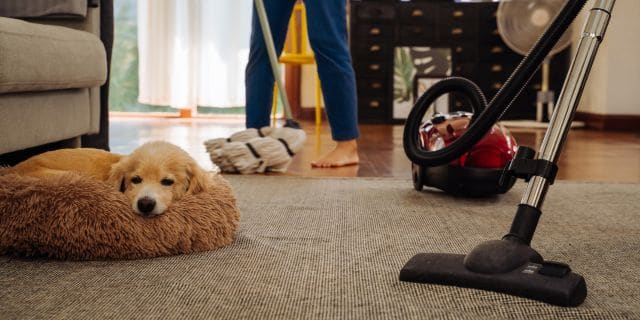
by California Casualty | Helpful Tips, Homeowners Insurance Info, Pets |
Thinking of adding a furry friend to your family? Or maybe your relatives are bringing their four-legged companion for a visit? Either way, ensuring your home is safe and welcoming for pets is important. From curious kittens to energetic pups exploring every corner, pet-proofing your space is essential to prevent mishaps. With a few simple tweaks, you can create a cozy and secure environment that’s perfect for both pets and people. Here’s a room-by-room guide.
Family Room/Living Room
- Furnishings: Pets love to jump, even if you don’t allow them on your furniture. Make sure it’s safe in case they get up there. Remove furniture that moves when jumped on (rocking chairs and chairs with wheels), and don’t leave reclining chairs open. They can close from the momentum of the jump, entrapping your pet. Add anti-scratch tape to the couch and other furniture to discourage scratching.
- Cords and wires: Pets love to play with dangling wires. Make sure cords from lamps, TVs, and other appliances are out of reach or taped down. You can use a pet-safe bitter apple spray to deter chewing. Cover electric cords or put them away when not in use. Follow guidelines for extension cord safety.
- Knickknacks and toys: Be prepared for décor and knickknacks to be knocked over. Keep them out of reach of curious pets. Remove children’s toys to avoid damage and potential choking hazards.
- House plants: Many plants can be poisonous to pets. Move them out of reach, possibly to a room where the door is closed so pets have no access. Fortunately, there are many pet-friendly plants that you and your fur baby can both enjoy.
- Fireplace and heaters: Place dog beds and blankets away from fireplaces or heaters. Block off access to the fireplace for pets just as you would for young children.
- Windows: Pets love to look out the window. Make sure your windows are closed. Install window guards so curious pets don’t accidentally fall through.
Kitchen
- Cabinets: Pets can pry open cabinets. Add childproof latches to cabinets within their reach so curious paws and noses can’t get in.
- Stove: Put up a stove guard to keep cats from jumping on a hot surface. Always supervise cooking. Don’t leave your stove unattended with pets in the house.
- Dishwasher: Close the dishwasher when not in use. Dishwasher detergent has chemicals that can cause severe irritation to the mouth and well as gastrointestinal upset. Plus, sharp objects like knives with food residue can be enticing for pets, and cause injury.
- Counters: Food can entice pets to jump up on counters. Even if the food is safe for them to eat, you don’t want them there. Store food in containers with tightly closed lids or in the fridge. Layering aluminum foil can keep cats from jumping on counters.
- Trash cans: Keep garbage in pet-safe trash containers. Some are heavy enough so they can’t easily be knocked over and others come with locks. You can also tuck trash cans away in a closet or cabinet.
Bathroom
- Cleaners: Store cleaning products and other hazardous chemicals out of reach to keep curious pets safe. Consider using cabinet latches to secure lower cabinets, and for dogs, placing items on high shelves can provide extra protection.
- Medication: Always store medications in a secure cabinet or drawer. Even small amounts of medications can be toxic to pets if ingested.
- Toilet: Keep the toilet lid closed to prevent pets from drinking water that may contain harmful chemicals. Use a toilet roll protector to keep playful pets from making a mess.
- Accessories and bath items: Keep small items like hair accessories, loofahs, and razors out of reach. These items can pose choking or ingestion risks and laceration hazards.
- Hair-styling heat tools: Always unplug and store curling irons, straighteners, and other heat tools immediately after use to prevent burns or accidents.
Bedroom
- Closets: Keep closet doors closed to prevent pets from accessing laundry or shoes. Items like drawstrings, buttons, or small accessories can be dangerous if chewed or swallowed. Don’t forget to check under the bed for loose socks or undergarments and store them safely out of reach.
- Curtain Cords: Dangling cords can be irresistibly tempting for pets but pose serious risks of entanglement or injury. Tie them up securely or opt for cordless window treatments to eliminate the hazard.
- Bedside Table: Store medications, lotions, and cosmetics in drawers or on higher shelves, away from curious noses and paws. These items can be harmful if ingested.
- Charging Cables and Electrical Cords: Keep electrical cords out of reach to prevent chewing, which can lead to electric shocks or burns. Charge devices on a high shelf, and tuck away charging cables when not in use.
Other Spaces
- General: Use pet gates to section off certain areas for dogs. Keep in mind that gates are less effective for cats, as they can climb or jump over them.
- Laundry Room: Always keep washer and dryer doors closed. Before starting the dryer, ensure no pets, especially cats, have climbed inside. Block small spaces behind washer and dryer units to prevent pets from getting stuck. Store dryer sheets in a sealed container on a high shelf; they contain chemicals that can cause gastrointestinal upset, skin irritation, and other serious health issues.
- Garage: Store chemicals like antifreeze, paints, and cleaners on high shelves or behind locked doors. Clean any antifreeze spills immediately—just a small amount can be lethal if ingested. Keep sharp tools and objects safely stored and remove any mouse or insect traps that could harm pets.
- Yard: Avoid letting pets into the yard immediately after applying pest control chemicals. Check that all outdoor plants are safe and non-toxic for pets. Repair holes in fences to prevent pets from escaping. Store lawn and gardening tools securely when not in use. Keep pets away from compost piles, mulch, and fertilizers, which can be harmful if ingested. Choose a pet-safe ice melt for your property during the winter months.
- Balconies and Swimming Pools: Block access to balconies or use barriers to prevent falls, especially for small pets. Restrict access to swimming pools when not supervised to prevent drowning accidents.
- Finally, don’t forget to protect your fur baby with pet insurance for added peace of mind, and to save on your vet bill. Remember, you can easily add pet insurance from Pet’s Best to your California Casualty auto or home policy. Find out more about what pet insurance can cover by talking with a California Casualty customer service representative today.
This article is furnished by California Casualty, providing auto and home insurance to educators, law enforcement officers, firefighters, and nurses. Get a quote at 1.866.704.8614 or www.calcas.com.
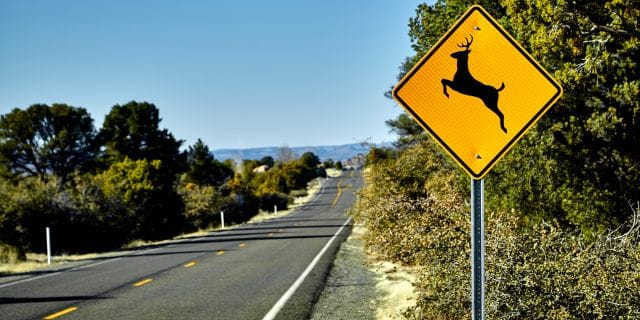
by California Casualty | Auto Insurance Info, Safety |
It’s a moment every driver dreads: the sudden thud, the jolt of your car, and the sinking realization that you’ve hit an animal. Your heart races, and questions flood your mind—what should you do next? Knowing how to respond calmly and responsibly in this situation can make all the difference. Let’s break down the steps to take if you find yourself in this unfortunate situation.
Honk and brake.
You see a deer—or a raccoon, coyote or other animal. Your first instinct might be to swerve. Think twice, as it could put you directly into oncoming traffic or cause you to crash into the trees. The best thing to do is sound your horn and hit your brakes. The hope is the animal will be startled and run, or that you’ll slow down enough to lessen the impact. The only time you should swerve is for animals, like moose, that weigh 1,000 lbs. or more.
Pull over to the side of the road.
Hitting an animal can be nerve-wracking. Do your best to remain calm. You’ll want to pull over safely to the side of the road as soon as possible. Turn on your hazard lights. Put up flares if you have them so you’re visible to other drivers. If it’s dark and the animal is lying on the road, you can point your headlights toward it, so the animal is visible to other motorists.
Check yourself and your passengers for injuries.
You just experienced a collision. Check yourself and your passengers for injuries, and if anyone needs immediate medical attention, call 9-1-1. Otherwise, attend to any pressing injuries using your first aid kit.
Call the police.
Report the accident to the police. (In some areas, there are fines for not reporting collisions with animals who are 55 lbs. or more.) You will want to let them know if the animal is obstructing the road and is a danger to other drivers. The police will file a report which you can use when you submit an insurance claim.
When it’s safe, get out of your vehicle.
The only times you shouldn’t exit your vehicle is if you hit a predatory animal like a mountain lion or bear, or if conditions outside are dangerous. When you feel comfortable, get out of your car and survey the scene. Carry a light so that any approaching vehicles will be able to see you.
Do not approach the animal.
Take stock of the animal from a safe distance but do not approach. If the animal is hurt, it could be afraid, dangerous and unpredictable. Do not try to move the animal; wait for police or wildlife control assistance. If you hit a farm animal or a family pet, there may be a tag or other identification. This will allow you to contact the owner. Owners of farm animals that are not correctly corralled could be charged with negligence and could be required to pay for your damages.
Take photos of any damage.
Collisions with animals could cause significant damage to your vehicle, including dents you can see and issues you cannot. Take pictures of any damage to your car’s body or bumper. Also take photos of the area around the accident. Make notes about what happened, including road conditions, exact location, date, time, and any other details that tell the story.
Contact your insurance company.
If your car is damaged, you may want to file a claim with your insurance company. You will need comprehensive coverage for collisions with animals. This is an optional addition to your standard vehicle insurance policy. If you don’t have this coverage, you may want to consider adding it.
Take your car to a reputable auto body shop.
You had an accident, and you want to make sure there’s no damage below the surface that you cannot see. If you have a diagnostic scan tool, you can use it to pinpoint issues and know whether your car is safe to drive. You will want to get your car checked out with your trusted mechanic to make sure everything is still working well.
Reduce Your Risk of Hitting an Animal.
You can take steps to reduce your risk of hitting an animal in the future. Follow these guidelines.
- Animals are more active at dusk and dawn. Be alert during these hours.
- Pay attention to animal crossing signs. These are areas where animals are likely to be.
- Look for movement along the side of the road. That could indicate an animal nearby.
- Be careful when roads are slippery, and visibility is reduced.
- Use your brights to see farther at a distance, if other cars are not coming the opposite direction.
- Ask your passengers to watch out for animals too. Another set of eyes is always helpful.
- Avoid distractions that could take your attention away from the road.
Finally, make sure your vehicle is protected with the right insurance. This will help your peace of mind should you get into an accident. Safe travels.
This article is furnished by California Casualty, providing auto and home insurance to educators, law enforcement officers, firefighters, and nurses. Get a quote at 1.866.704.8614 or www.calcas.com.
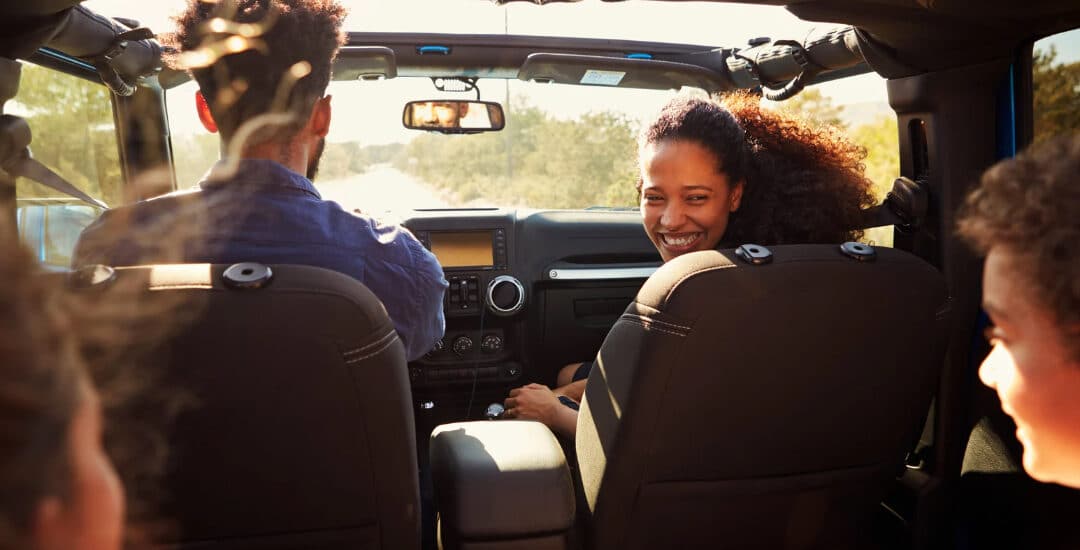
by California Casualty | Auto Insurance Info, Helpful Tips |
Turn your next drive with your kids into a meaningful moment. Whether it’s a quick trip to the store or a longer journey, being in the car together can spark conversation. It’s the perfect chance to connect and dive into the little things that matter most. With fewer distractions, the car becomes a place where stories flow, questions unfold, and you create memories that last beyond the ride. Here are some guidelines to get the conversation started.
Create an Inviting Atmosphere for Great Conversations
- Ensure it’s easy to listen and be heard by keeping distractions to a minimum—turn down the radio and ask everyone to stow away devices.
- Mix up the topics with a balance of fun and thoughtful discussions that match your child’s age and interests.
- Keep the vibe upbeat and supportive—focus on connecting rather than correcting.
- Engage by listening just as much as talking. Listening is the key to deepening your bond.
- Encourage open dialogue by asking questions that spark more than a yes or no response.
- If the conversation doesn’t flow right away, stay patient and keep the lines of communication open.
Creative Ways to Build Stronger Connections
Try any of these creative approaches to tap into topics that are meaningful to your child or teen.
Hobbies and Interests:
Whether your kids are into sports, art, reading, or something else, ask them about it. Your interest shows that their hobbies matter and helps boost their confidence. Inquire about the latest scrimmage, the book they’re reading, their favorite TV show or another beloved activity. You will want to show genuine curiosity and pose follow-up questions. Remember, your role isn’t just to guide, but to celebrate their unique interests and growth.
New Technology:
There are plenty of fun, new gadgets and apps that help us manage our world. Talk with your children about some of the latest tech. Then reveal what the world was like, before they were born, without this technology. Help them imagine what it was like with an engaging story or two. Ask them what new technology of the future should be invented. You never know how that might inspire them.
Current Events:
Talking about social media trends or other age-appropriate current events with your teens is an opportunity to teach them about the world and develop their critical thinking. Encourage them to share their thoughts and opinions, asking open-ended questions like, “How do you feel about what’s happening?” or “What do your friends think about this?” These discussions can help them process information, understand different perspectives, and build a sense of empathy and awareness. Create a safe space for them to ask questions or express concerns.
Role Plays:
Car rides can be the perfect time to role-play with your child and help them work through different problems in a relaxed setting. You can create scenarios based on challenges they may face, like dealing with a disagreement at school or preparing for a big test. By playing different roles, you can guide them to think through solutions, practice how to respond, and build confidence in handling tricky situations. It’s a great way to engage their problem-solving skills. Plus, the casual environment of the car makes it feel less pressured for both of you.
Fun and Silly:
For a lighthearted and engaging conversation with your kids, try mixing in some fun and silly questions. Ask them, “If you were an animal, what would you be?” or “What food could you eat every day for the rest of your life?” These boredom-busting questions can spark creativity and laughter. You might also ask, “If you could switch places with anyone in the world, who would it be?” or “If you could change your name, what would it be?” For an extra challenge, try speaking only in questions to keep the conversation flowing in unexpected ways. And when all else fails, throw in a dad—or mom—joke to lighten the mood!
Driving Safety:
Being in the car is a natural time to talk about vehicle safety. Again, keep the conversation age appropriate. If you have a teen, point out decisions that you make as you drive, and share safety tips such as how to safely pull over on the side of the road. Note the dangerous behaviors that you see from other drivers such as tailgating. Get them ready to focus on the road by asking them to navigate and tell you where you should turn. For younger passengers, point out road signs for stop, yield and crosswalks. Ask them what they notice when looking outside the window. Talk about why we wear seatbelts and what could happen if we forget. Teach them safety around vehicles.
Finally, you’re traveling with precious cargo when you transport your family. Make sure your car is well-maintained and protect it with the right car insurance. Safe travels.
This article is furnished by California Casualty, providing auto and home insurance to educators, law enforcement officers, firefighters, and nurses. Get a quote at 1.866.704.8614 or www.calcas.com.
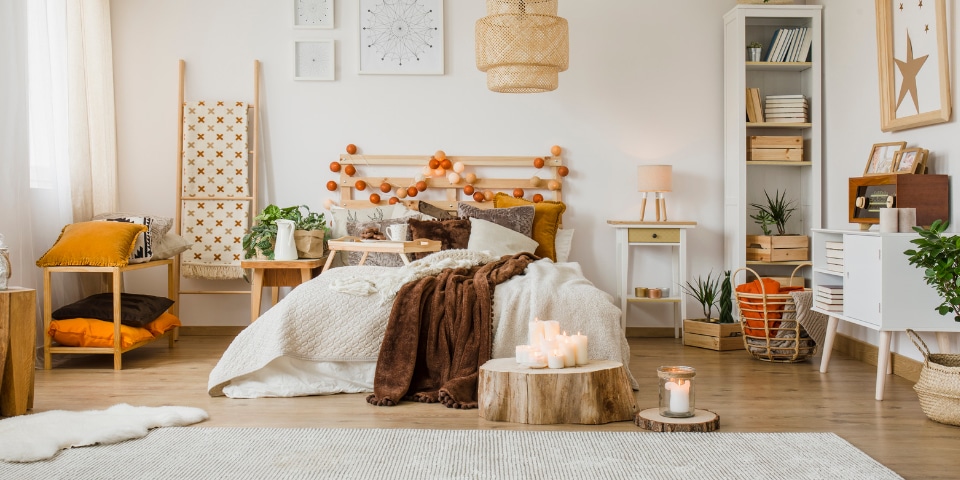
by California Casualty | Helpful Tips, Homeowners Insurance Info |
Picture a living room where soft throws, flickering candles, and calming neutral tones create a haven of warmth and relaxation. That’s the idea behind Hygge, the Danish art of coziness. Whether you’re unwinding with a cup of tea or enjoying a quiet moment, a hygge-inspired space wraps you in comfort and serenity. Ready to embrace the cozy life? Let’s explore how to turn your living room into the ultimate snug retreat.
What exactly is Hygge?
Hygge (pronounced hoo-ga) is a Norwegian word that means coziness. It’s a Danish concept characterized by simplicity that embodies a feeling of comfort and contentment. At its core, hygge is about slowing down and savoring moments that bring joy and relaxation, helping to create a sense of well-being and balance in everyday life.
Elements of Hygge Design
Hygge design is all about simplicity and functionality. Here are some easy ways to incorporate hygge elements into your living room.
Space
Hygge spaces are uncluttered, light and airy spaces with distinct areas.
- Clutter is stressful. The first step is to declutter your room. This gives you the blank canvas to thoughtfully consider what belongs here.
- If you’re ready for a painting project, paint your walls in a light earth tone such as white, off-white or cream.
- Add sheer drapes or window coverings in shades of those same colors.
- Plan out cozy places within the room to gather, such as a reading corner and conversation nook.
Furnishings
When considering your furniture, look for modern, minimalistic designs.
- Draw inspiration from Scandinavian furniture with clean lines, rounded edges and tapered legs.
- Avoid stiff furnishings. Instead choose a chair with overstuffed arms or super soft upholstery.
- Blend old and new. You can incorporate vintage furniture next to modern.
- Arrange seating for conversation and interaction, rather than around the television.
- Less is more but make sure you have ample seating for everyone.
Calming Neutrals
The neutral color palette used in hygge design draws inspiration from nature.
- Choose calming tones such as creams, grays and browns. Think of the colors that you find in natural shades of wood.
- Select patterns with similar colors that will not disrupt the harmony.
- Avoid bright pops of color. Instead, go deeper with earth tones.
- Everything you add should create a peaceful atmosphere.
Tactile Textiles
A neutral palette allows the textures to really stand out.
- Choose materials that invite you to touch them, such as fluffy pillows, thick knits, boucle blankets, and items made of linen, cashmere, and fuzzy mohair.
- Add a deep pile area rug that invites your toes to sink in.
- Layer your textures. Group together throws and cushions of different textures.
- Pile blankets high in a wicker basket within easy reach of your seating area.
Soft Lighting
Lighting creates the right ambiance for relaxation.
- Just as you layer fabrics, you can layer lighting. Choose an overall dimmer switch for full room lighting that can be adjusted to fit your mood. Then add pockets of lighting in areas within your space.
- Use a floor lap or table lamp in your reading nook. Choose light bulbs with a warm color temperature. Lamps with frosted shades offer beautiful, filtered light.
- Candles provide a flickering glow. Choose flameless varieties that are safe around kids and pets, for increased fire safety.
- Twinkling lights give off a softer light than your overhead light. Choose tiny white or clear lights that work with hygge décor.
Natural Elements
Hygge is inspired by a connection to nature. Bring those natural elements inside.
- Add potted plants, fresh or dried flowers, for some natural inspiration.
- Incorporate organic materials like wood and stone in furniture and décor.
- Consider wood floors, wooden bookcases and shiplap paneling on walls.
- Display artwork depicting scenes in nature or using natural items or themes.
Décor
Hygge is about minimalism. You’ll want to keep your décor simple and meaningful.
- Display your treasures—the things that are meaningful to you. That includes children’s artwork, DIY crafts and family photos.
- Avoid overcrowding shelves and tables with knickknacks.
- Less is more when it comes to décor. Start with a blank slate and add one or two pieces to create that cozy, welcoming feel.
Your home is one of your greatest investments. Make sure to protect it – and your valuables – with the right insurance.
This article is furnished by California Casualty, providing auto and home insurance to educators, law enforcement officers, firefighters, and nurses. Get a quote at 1.866.704.8614 or www.calcas.com.





